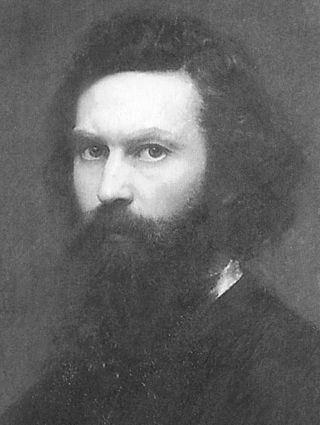Notes
This article includes a list of references, related reading, or external links, but its sources remain unclear because it lacks inline citations .(July 2014) |
Heinrich Spiess (born in Munich, May 10, 1832; died there, August 8, 1875) was a German painter.
He was the son of an engraver, completed his studies under Kaulbach, whom he assisted in his cartoon of “The Crusaders,” and executed a celebrated copy of his “Angel carrying a Dead Child to Heaven.” In 1855 he was employed by Kaulbach in decorating the Wartburg. In 1856 he obtained a prize for his “Jacob Wrestling with the Angel,” and in 1861-62 he painted for the museum of Munich the great frescoes relating to the pilgrimage of Duke Henry the Lion to Jerusalem, and to his quelling the disturbances at St. Peter's at the coronation of the emperor Frederick I.
This article includes a list of references, related reading, or external links, but its sources remain unclear because it lacks inline citations .(July 2014) |

Heinrich Theodor Böll was a German writer. Considered one of Germany's foremost post-World War II writers, Böll received the Georg Büchner Prize (1967) and the Nobel Prize for Literature (1972).

Wilhelm von Kaulbach was a German painter, noted mainly as a muralist, but also as a book illustrator. His murals decorate buildings in Munich. He is associated with the Düsseldorf school of painting.

Christian Heinrich Spiess was a German writer of romances and later pulp fiction, horror stories.

Samuel Amsler, a Swiss engraver, was born at Schinznach, in the canton of Aargau. He studied his art under Johan Heinrich Lips (1758–1817) and Karl Ernst Hess, at Munich, and from 1816 pursued it in Italy, and chiefly at Rome. In 1829, he succeeded his former master Hess as professor of engraving in the Munich academy. The works he designed and engraved are remarkable for the grace of the figures, and for the wonderful skill with which he retains and expresses the characteristics of the original paintings and statues. He was a passionate admirer of Raphael, and had great success in reproducing his works. Amsler's principal engravings are: The Triumphal March of Alexander the Great, and a full-length Christ, after the sculptures of Thorwaldsen and Dannecker; the Entombment of Christ, and two Madonnas after Raphael; and the Union between Religion and the Arts, after Overbeck, his last work, on which he spent six years. His portrait album, now in the Ashmolean Museum, Oxford, includes a fine head of the poet Friedrich Rückert.(1) A family portrait of Amsler by Wilhelm von Kaulbach is now in the Victoria and Albert Museum, London.(2)The portrait on the right is also by von Kaulbach (1833).

The New Town Hall is a town hall that forms the northern part of Marienplatz in Munich, Bavaria, Germany. It hosts the city government including the city council, offices of the mayors and a small portion of the administration. In 1874 the municipality had left the Old Town Hall for its new domicile.

Kreimbach-Kaulbach is an Ortsgemeinde – a municipality belonging to a Verbandsgemeinde, a kind of collective municipality – in the Kusel district in Rhineland-Palatinate, Germany. It belongs to the Verbandsgemeinde Lauterecken-Wolfstein.

Theodor Friedrich Wilhelm Christian Kaulbach was a German painter from Bad Arolsen, Principality of Waldeck and Pyrmont. His father was Christian Kaulbach (1777–1847), a cabinet maker in Arolsen. He was also the cousin and at one time the student of the painter Wilhelm von Kaulbach, son of Philipp Karl Friedrich v. Kaulbach (1775–1846), goldsmith and amateur painter.
Georg Mader was an Austrian painter.

The Liebig Medal was established by the Association of German Chemists in 1903 to celebrate the centenary of Justus von Liebig. Since 1946 it has been awarded by the Society of German Chemists.
Hans Sigmund Bendel was a Swiss painter and illustrator.

Friedrich August von Kaulbach was a German portraitist and historical painter.

The Munich school is a group of painters who worked in Munich or were trained at the Royal Academy of Fine Arts of Munich between 1850 and 1918. In the second half of the 19th century the Academy became one of the most important institutions in Europe for training artists and attracted students from across Europe and the United States.

Louis Asher, originally Julius Ludwig Asher, (1804–1878) was a German artist.

Karl Adolf Spieß was a German gymnast and educator who contributed to the development of school gymnastics for children of both sexes in Switzerland and Germany.

Michael Echter was a German painter, known primarily for historical scenes.
Robert Cleon Spiess also known as Robert Spies was a German tennis player. He competed in two events at the 1912 Summer Olympics in Sweden. He was a quarter finalist in the men's doubles at the 1914 Wimbledon Championships partnered with Luis Maria Heyden. His biggest singles title wins were at the German International Covered Court Championships which he won two times in 1920 and 1926, and the German National Championships in 1912. He was active from 1910 to 1936 and won 6 career singles titles.

Albrecht Christoph Wilhelm von Diez was a German painter and illustrator of the Munich School.

Hermann von Kaulbach was a German painter of the Munich School.

Wilhelm Anton Kaulbach was a German portrait painter.

Herzog-Max-Palais was a neoclassical palace at Ludwigstraße 13 in Munich, Germany. It belonged to the House of Wittelsbach and was built from 1828 to 1830 for Duke Maximilian Joseph in Bavaria, father of Empress Elisabeth of Austria.